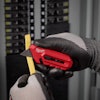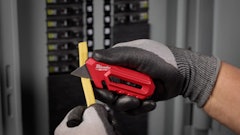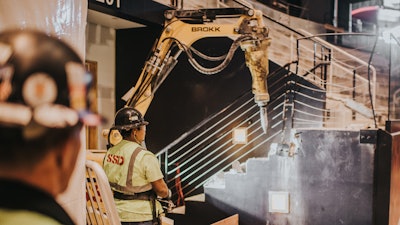
Information from this article was first published in Demolition Magazine and is being reused with permission from the National Demolition Association.
By Aaron Boerner
Just as basketball players often need to score big before the buzzer to win, the contractors completing the NBA’s second-largest renovation ever need to work fast to make sure the athletes have a court on which to compete.
The Atlanta Hawks announced a $192.5 million re-imagination of the Philips Arena in downtown Atlanta in June 2017. The three-phase project involves rebuilding the interior of the building from the roofline to the baseline, as well as making major changes to the arena configuration. The result will be new amenities on every level of the arena, a tremendous amount of open and connected space, new video boards, improved sightlines and the first-ever bar on an NBA playing floor.
The Atlanta Hawks hired a team of general contractors comprised of Turner Construction Company, AECOM Hunt, SG Contracting and Bryson Constructors to oversee the project. The first phase was chiefly demolition focused, requiring — among other things — removing a six-level wall of suites on the arena’s west side to make room for many of the improvements. Not only did the phase involve demolishing almost 3,000 tons of concrete, it also needed to be done in just 12 weeks to be ready for the new basketball season and upcoming concerts. Plus, unlike most projects where one contractor finishes and another begins, all contractors had to start working on the arena at the same time with no slack time built in.
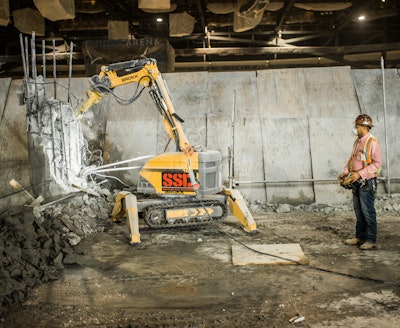 SSD knew using remote-controlled demolition machines would improve productivity over handheld tools, as well as keep workers safe from flying concrete and fall risks.Brokk
SSD knew using remote-controlled demolition machines would improve productivity over handheld tools, as well as keep workers safe from flying concrete and fall risks.Brokk
“Our plan to use these specialized machines was what won us the project,” says Gregory Gorman, SSD senior vice president. “The equipment is remarkably powerful for its size. Plus, the electric-powered machines eliminated the risk of exhaust fumes, which was a huge benefit for the interior demolition that was the bulk of our work.”
The contractor purchased two Brokk 160 remote-controlled demolition machines, which were vital to their plan. The company learned about the manufacturer, Brokk, in 2017 during a difficult top-down demolition project. Research at the time determined that suspending one of the machines from a crane was the best way to complete a safe, controlled demolition. SSD rented one for the 2017 demolition and continued to regularly rent the equipment. Based on their experience over the years of renting, SSD management knew purchasing the machines would be a good investment.
When the first phase of construction began in June 2017, SSD crews moved quickly, starting demolition of soft ceilings, offices, ribbon boards, retractable seating, pre-cast seating and vomitory walls. Crews also installed scaffolding, as well as deflection shields and chutes, for rubble containment and removal.
Demolishing the concrete suites by deadline required a strict six-day-a-week schedule with a 42-person crew rotating through two 10-hour shifts. Starting at the top level, the contractor placed one B160 at the north end of the stadium and the other at the south end. Two operators manned each machine — one using the remote control and one as a spotter. From there, operators worked their way toward the middle of the suites, demolishing concrete, pillars and utilities, as well as seating, handrails, floor and wall coverings, drywall and other items.
SSD used an Atlas Copco SB 202 hydraulic breaker attachment, and the unique Brokk three-part arm design allowed them to take advantage of extended reach capabilities and precise demolition. Operators switched to a steel-cutting attachment to cut through rebar, which reinforced much of the concrete. SSD President Michael Gorman said the attachment was a dramatic improvement over needing to cut with handheld torches.
“The Brokk salesman, John Haugabook, brought the attachment when he delivered the machine, anticipating our need to cut rebar,” Gorman says. “We’re glad he did. We tried the attachment, recognized the improvement to our process and bought it on the spot. Overall, the Brokk machines improve our productivity by as much as 50%.”
At night, the second crew cleaned rubble from the level below the day’s demolition areas. Workers loaded debris into hoppers by hand and with mini excavators and skid steers. A deflection field composed of plywood and scaffolding on the levels’ edges provided both fall protection and a way to contain rubble. Workers also used debris chutes and a service elevator to remove material.
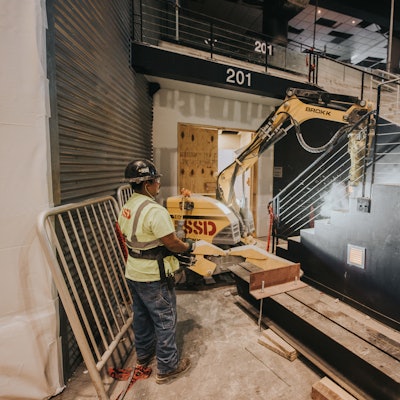 SSD wrapped up its portion of the project after 74 days of work, three days ahead of schedule. In total, the contractor recycled 2,760 tons of concrete from nine arena levels.Brokk
SSD wrapped up its portion of the project after 74 days of work, three days ahead of schedule. In total, the contractor recycled 2,760 tons of concrete from nine arena levels.Brokk
SSD used the Brokk machines for about four weeks to completely remove the suites’ walls. Beyond the suites, SSD completed additional architectural and structural demolition of major arena components. This included removing concrete slabs and foundations, as well as modifying raker beams and stairs.
SSD wrapped up its portion of the project in September after 74 days of work, three days ahead of schedule. In total, the contractor recycled 2,760 tons of concrete from nine arena levels.
Overall, phase one construction wrapped up in late October — just in time for an Eagles concert and basketball season to begin. Work on phase two began in November 2017. Phases two and three involved additional architectural work and the bulk of the construction of the new amenities, additions and layout. The project was completed for the 2018-19 basketball season, coinciding with the Hawks’ 50th anniversary in Atlanta.
Aaron Boerner is a writer for the construction, demolition, aggregates and mining industries.

